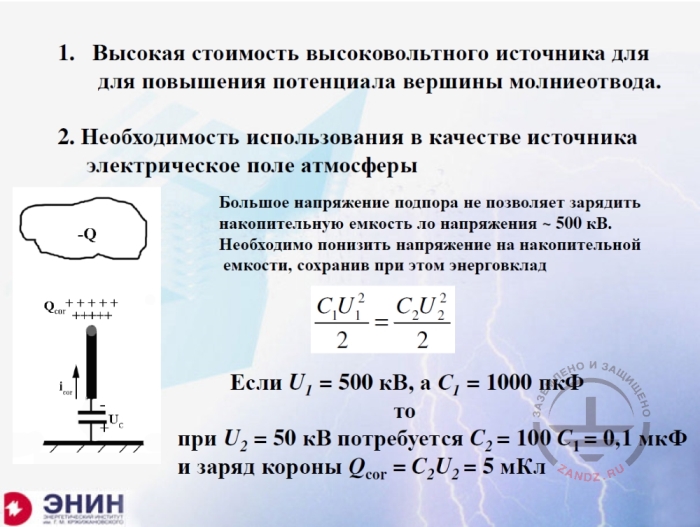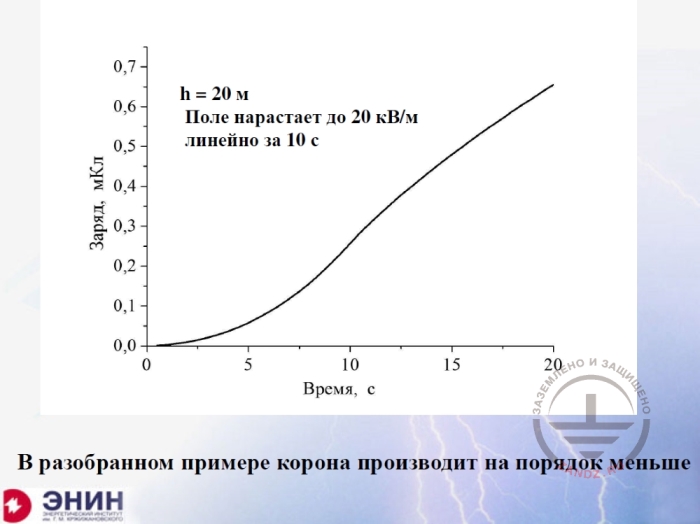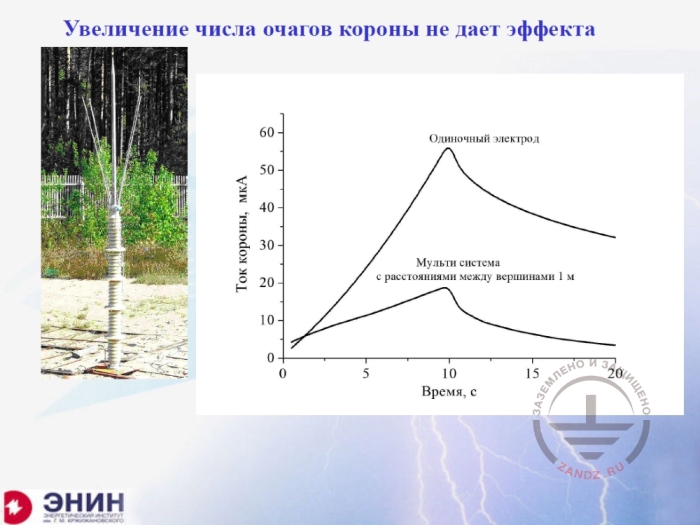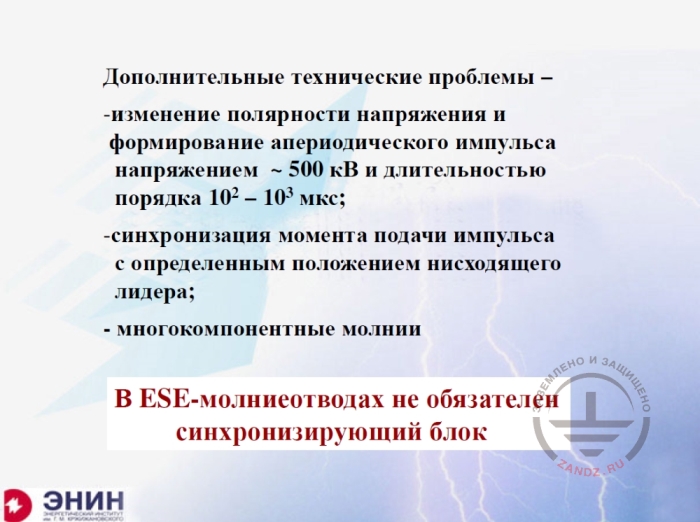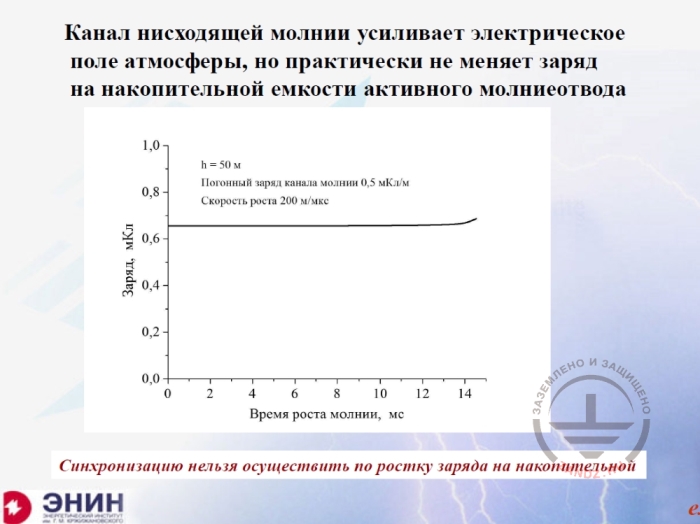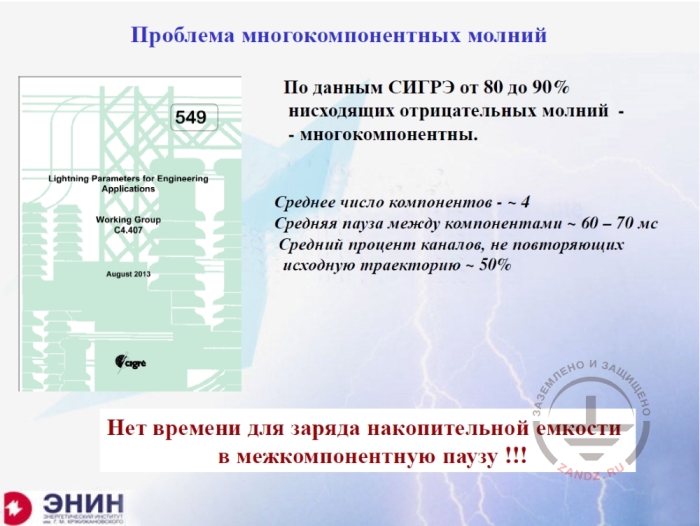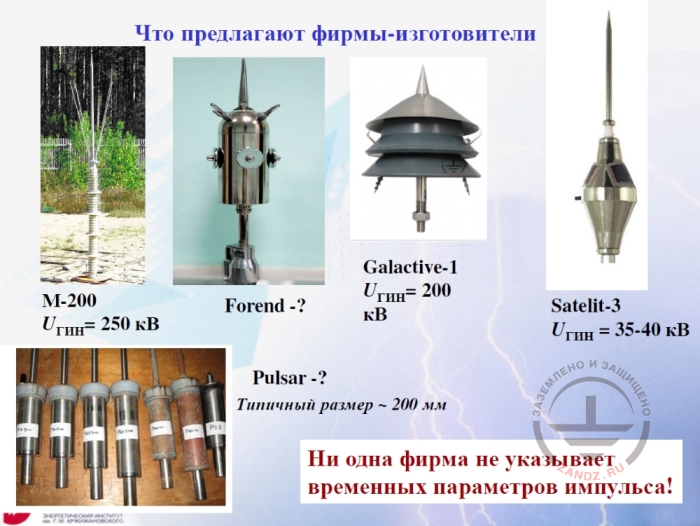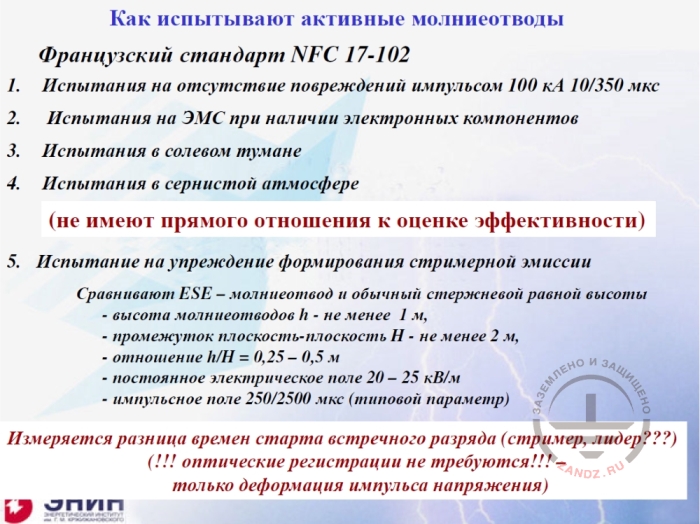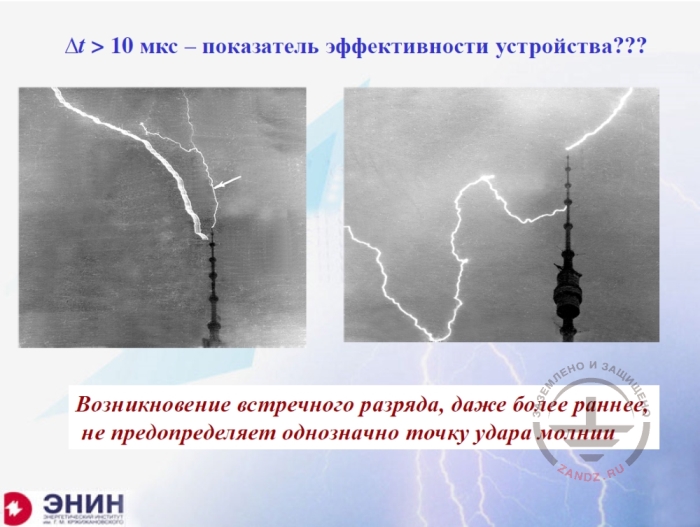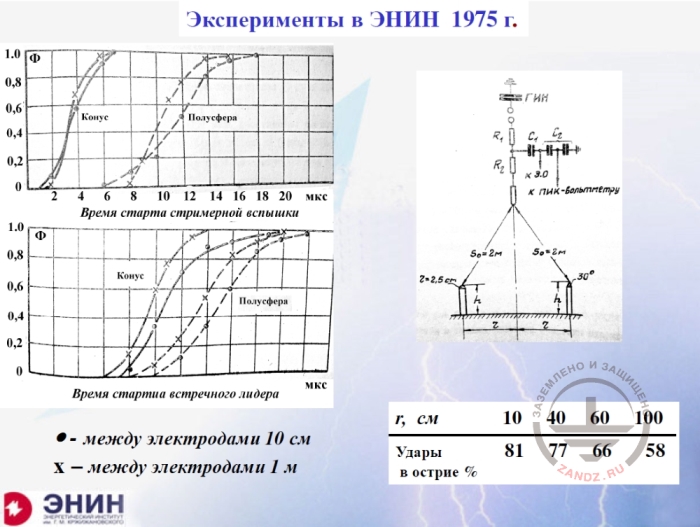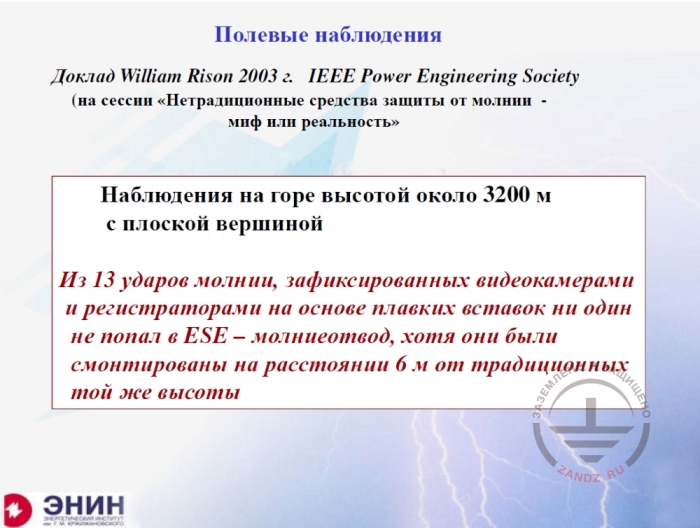The eighth webinar of a series "Grounding and lightning protection: issues and problems arising in the design"
Webinar text. Page 2
Quick navigation through slides:
1. How effective and feasible are ESE lightning rods
2. Seminar task
3. Regulatory framework
4. Is it possible to control lightning trajectory?
5. Basic phases of a counter discharge
6. Is it easy to shift corona into a streamer form?
7. When will sustainable leader appear?
8. Pulse duration
9. Energy intensity of the managing source
10. Implementation of the managing source
Page 2:
11. High cost of high-voltage source
12. In a manifold example, corona produces one order less
13. Increase of the number of corona centers doesn’t give any effect
14. Synchronizing block is not obligatory in ESE lightning rods
15. It is impossible to carry out synchronization on the charge growth on a cumulative
16. Problem of multi-component lightning
17. What do producing companies offer
18. How ESE lighting rods are tested
19. Device efficiency index
20. Experiment in ENIN in 1975
21. Experiments in “26 Central Research Institute” in 2014
22. Field observations
High cost of high-voltage source
Let's discuss the following thing. It is necessary to reduce voltage on charge capacities and increase the number of stages, arrange voltage multiplication system inside an ESE lightning rod. But if you, reducing the voltage, want to keep the energy capacity, you need to come out of the well-known correlation of energy equality. And if you reduced the voltage 10 times, for example from 500 kV to 50 kV, then you need to increase the capacity in 100 times. And instead of 1000 pF you will get 0,1 mcF. And now at 50 kV on the same capacity, you need to collect the charge of 5 mCl. What's this? What to compare this charge with?
In a manifold example, corona produces one order less
Заряд, мКл – Charge, mCl
Поле нарастает до 20 кВ/м линейно за 10 с – The field grows linearly to 2 kV/m in 10 seconds
Время, с – time, s
В разобранном примере корона производит на порядок меньше – The corona produces to an order of magnitude less in the studied example
And it is necessary to compare this charge with the charge created by the corona. And now I see, what charge can corona make in an electric field of a thunderstorm cloud? I took a typical lightning rod 20 meters high. I took typical conditions in an electric field of a thunderstorm cloud and saw what charge can corona accumulate in time period of 20 seconds - this is time between average lightning flashes. It means, this charge is about 10 times less the one I need. I can't accumulate this charge which I need for management at the expense of corona.
Increase of the number of corona centres doesn't give any effect
Ток короны, мкА – Corona current, mcA
Одиночный электрод – single electrode
Мульти система с расстояниями между вершинами – multi system with the distance between the tops
Время, с – time, s
And since I can't, people start to invent various things. For example, on the image you see, it is a picture at the laboratory tests of a lightning rod, which is called M-200. Look, what is it on the lightning rod? There is not one shielding point, but several. The idea is quite simple. Since one point doesn't manage the condenser's charge, I made them 5,10,20. As many as necessary. The situation is as follows. I can make the electrodes I need. But it doesn't increase the summary corona current.
In ESE lightning rods a synchronizing block is not obligatory
Additional technical problems -
- Change of voltage polarity and formation of aperiodic pulse with the voltage of ~500 kV and duration about 10(2)- 10(3) ms;
- Synchronization of the moment of pulsing with a certain position of the downstream leader
- Multi-component lightning
It is not obligatory that there is a synchronizing block in ESE lightning rods.
The issues I mentioned are the most important. But there are a couple of serious problems beside them, if I decide to design ESE lightning rods. The thing is I need to change the voltage polarity when charging. Of course, you can change voltage polarity. Throw off the pulse of opposite polarity, but it requires additional devices and space, but there is none. And there's another thing. And this is the following. It is necessary for the managing device to give a managing pulse in a required time moment. If it gives it when the leader approaches the ground - it's too late. If it gives it when the leader has just originated in the cloud, it won't manage to feel this managing impact. So, synchronization is absolutely required. And on the major part of electrodes, there is no synchronization. And it is very difficult to make this synchronization. And the reason is as follows. The parameters of the forming lightning change randomly within about 2 orders of magnitude. And it is hard to make a reliable synchronization in these conditions. It costs money and that is why it is absent in the majority of devices. And finally, I will repeat what I've said before. Operating speed. In order to manage with the multi-component lightning, it is necessary to have a very quick charging device. We can't charge it in 20 seconds, but it is necessary to do it in 0,1 s.
It is impossible to carry out synchronization on the charge increase on the ccumulative
The channel of the downward lightning enhances the electric field of the atmosphere, but practically doesn’t change the charge on the cumulative capacity of the active lightning rod
Заряд , мКл – charge, mCl
Погонный заряд канала молнии – Linear charge of the lightning channel
Скорость роста – growth rate
Время роста молнии, мc – lightning growth time , ms
Синхронизацию нельзя осуществить по ростку заряда на накопительной – Synchronization can’t be carried out by the charge spire on the cumulative
All this together makes us think about the following. It makes us think, that those technical problems which constructors of ESE lightning rods have, are hard to be resolved.
Problem of multi-component lightning
According to CIGRE data from 80 to 90% of downward negative lightning are multi-component
Average number of components – 2
Average pause between the components – 60-70 ms
Average percent of channels not repeating the source trajectory – 50^
There is no time for the charge of the cumulative capacity in the inter-component pause!
Now I want to look at these ESE lightning rods. I took various pictures from the Internet.
What is offered by companies manufacturing active lightning protection
No company indicates time parameters of the impulse!
And now I want to tell you, what I can learn about them from the documents in the Internet? Or in promotional brochures? I can learn dimensional sizes. As a rule, these dimensional sizes are counted in several dozens of centimetres in the majority of cases. It is impossible to put a high-voltage pulse device, which can give about 500 kV with the duration of hundreds of ms into several dozens of centimetres. Nobody can do it. This is the first moment. The second moment which is crucial for me. If I can find the value of the managing voltage which is done by this ESE lightning rod in the passport data. See, there are different figures here, from 250 kV to 35 kV approximately. I put those down, which I found in passport data. You can't find time anywhere. Managing pulse parameters are now demonstrated anywhere. What impulse is it? You have no idea about it and can only guess according to a single reason. You can study the catalogue of companies, which produce high-voltage condensers, look at the sizes of these condensers and see what condensers can be put into these ESE lightning rods, which we see on these pictures. Not a very riant picture I would say.
How are ESE lightning rods tested
French standard NFC 17-102
-
Test on the absence of damages by 100 kA pulse 10/350 ms
-
Test for electromagnetic inductance at the presence of electronic components
-
Test in salt fog
-
Test in sulphur atmosphere
DO NOT have direct relation to the efficiency estimation!
-
Test for preventing streamer emission formation
ESE lightning rod and a conventional lightning rod of equal height are compared
- Height of lightning rod is not less than 1 meter
- The distance surface-surface H is not less than 2 m
- Relation h/H= 0,25 – 0,5 m
- Stable electric field 20-25 kV/m
- Pulse field 250/2500 ms (typical parameter)
The difference of counter charge start time is measured (streamer leader???)
(!!! Optical registrations are not required!!! Only deformation of voltage pulse)
Let's have a look at another moment. And this is the following. What do companies producing ESE lightning rods show? What do these companies show to their customers? I studied the modern French standard, which shows how to test ESE lightning rods and how to judge whether they are fine or not. I am showing you the real extracts from the standards. The first test - is a test for lightning current equal to 100 kA 10/350 ms to make sure the device is not damaged and remained mechanically safe. The next test for electromagnetic compatibility, if there are some semi-conductor or micro-processor managing devices. If there are none, they must not be tested. Then device test for its functioning in a salt fog. And a test in sulphur atmosphere. All these tests have no relation to the efficiency of ESE lightning rods operation. It is the same as if you were allowed to test an airplane and you would test the strength of chairs, brightness of light and volume of petrol tanks. But when it was time to test an airplane, you would say - why to test it? It's an airplane, it should fly. Companies do practically the same. What do they offer to test? They offer to test the following. It offers to put the head of an active lighting rod into a discharge gap, less than 2 meters long, and put an ordinary lightning rod near. Then give a voltage pulse with the front of 250 ms to it and see from which lightning rod - ESE or ordinary - streamer flash appears. If this streamer flash from an active lightning rod overhauls the ordinary lightning rod to 10 ms, the French standard considers this active lighting rod applicable for practical use. That's it!
Device efficiency index
Appearing of a counter charge, even earlier one, doesn’t foresee the lightning strike point
У меня возникает вопрос, а на каком основании это делается? Почему, вдруг возникновение даже не встречного лидера, а возникновение более ранней стримерной вспышки считается показателем активного молниеотвода? Когда вели наблюдение за реальными объектами, часто видели и такую вещь. Смотрите, от вершины молниеотвода родился встречный лидер. Вот он. Видите? А молния промахнулась мимо него. Даже появление встречного лидера не доказывает, что молниеотвод работает. Почему французы сделали такую лихую вещь, к сожалению, спросить не у кого. Зато есть возможность посмотреть, а что, вообще говоря, есть в лаборатории более рано, ранние возникновения этой стримерной вспышки делает?
Experiments at ENIN in 1975
Время старта стримерной вспышки – streamer flash start time
Конус - cone
Полусфера - semi sphere
Время старта встречного лидера – counter leader start time
Между электродами – between the electrodes
Удары в острие – strike into the edge
Such experiments were held in Russia, at ENIN. And in order to ignite the early streamer emission, it turned out that no additional voltage was necessary. It is enough to put two electrodes. Take one electrode with a sharp conic head, and the second - of the same height with a hemi-sphere head. And we get time scatter statistics. It is time statistics with the conic head, and this - with a hemisphere head. The leader at the hemi-sphere head was always late. So, if to trust the French, the charge should always hit the sharp electrode, it should strike here. And here is the statistics. If to part the electrodes to one meter, the number of strikes into these two electrodes will differ in the range of 8%. So, roughly speaking doesn't differ at all. Now you can judge the efficiency of French tests.
Experiments at "26 Central Research Institute" in 2014
Result: ESE lightning rod doesn’t have any advantages; at a negative voltage up to 70% of spark charges are affected by the passive electrode
In order to judge seriously about it, there was a very large report at the lightning protection conference in Saint-Petersburg by Kuprienko and his colleagues who did absolutely the same. They took an ESE lightning rod M-200, which I mention and an ordinary one. They put them near each other. Created an electric field of a thunderstorm cloud at the expense of a special device. And then gave impulses with the front of 250 ms to this system, as the French did. I won't tell you about the whole experiment in detail, because there are some nuances which we could discuss. I want to tell you the main thing. And the main thing was as follows.
Field observations
William Rison report
At the session “Untraditional lightning protection means – myth or reality
Observations o the mountain about 3200 m high with a flat top
Out of 13 lightning strikes, fixed by video cameras and registers on the base of fuse links, no strike got into ESE lighting rod, though they were mounted at the distance of 6 meters from the conventional rods of the same height
You see? Before them, there was a special session of the association of engineers, electricians and electronic engineers in 2003 which was called "ESE lightning rods - myth or reality?". And a ground of American specialists under the head of Rison reported the results of comparative tests of ESE and conventional lightning rods at this session. They did the following thing. There is a mountain 3200 meters high with a flat top near the university in New Mexico and they put a group of ESE and a group of conventional lightning rods there. They had been monitoring them during 3 years. And during 2 years there were automatic cameras which recorded the strike point. The result was impressive. Lightning did not strike into a conventional lightning rod, neither they hit the ESE lightning rod at all. Now there's a question. What to think about all that? What to think about ESE lightning rods in this situation? Ad what to think about the experiments held. These are serious people. It is impossible to believe that they lied in their experiments or measured something improperly. But there should be some explanation.
<< Previous Page
slides from 1 to 10
Next Page >>
slides from 23 to 26 + questions and answers session
Useful materials for designers:
- Webinars with the leading industry experts
- Everything for the calculation of grounding and lightning protection
- Useful materials: articles, recommendations, examples
Related Articles:
 Lightning protection of residential and public buildings - answers to frequently asked questions in the design
Lightning protection of residential and public buildings - answers to frequently asked questions in the design
 Lightning Protection of Large Territories: Parks, Grounds, Plant Territories. Page 1
Lightning Protection of Large Territories: Parks, Grounds, Plant Territories. Page 1
 Lightning Protection of Large Territories: Parks, Grounds, Plant Territories. Page 2
Lightning Protection of Large Territories: Parks, Grounds, Plant Territories. Page 2
 Lightning Protection of Large Territories: Parks, Grounds, Plant Territories. Page 3
Lightning Protection of Large Territories: Parks, Grounds, Plant Territories. Page 3


